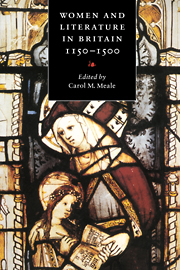Book contents
- Frontmatter
- Contents
- List of illustrations
- List of abbreviations
- Chronology: women and literature in Britain, 1150–1500
- Introduction
- 1 The power and the weakness of women in Anglo-Norman romance
- 2 Women as lovers in early English romance
- 3 Mothers in Middle English romance
- 4 ‘Clerc u lai, muïne u dame’: women and Anglo-Norman hagiography in the twelfth and thirteenth centuries
- 5 Women in No Man's Land: English recluses and the development of vernacular literature in the twelfth and thirteenth centuries
- 6 ‘Women talking about the things of God’: a late medieval sub-culture
- 7 ‘… alle the bokes that I haue of latyn, englisch, and frensch’: laywomen and their books in late medieval England
- 8 Women authors and women's literacy in fourteenth- and fifteenth-century England
- 9 Women and their poetry in medieval Wales
- Further reading
- Index of manuscripts
- Index of names and titles
4 - ‘Clerc u lai, muïne u dame’: women and Anglo-Norman hagiography in the twelfth and thirteenth centuries
Published online by Cambridge University Press: 09 November 2009
- Frontmatter
- Contents
- List of illustrations
- List of abbreviations
- Chronology: women and literature in Britain, 1150–1500
- Introduction
- 1 The power and the weakness of women in Anglo-Norman romance
- 2 Women as lovers in early English romance
- 3 Mothers in Middle English romance
- 4 ‘Clerc u lai, muïne u dame’: women and Anglo-Norman hagiography in the twelfth and thirteenth centuries
- 5 Women in No Man's Land: English recluses and the development of vernacular literature in the twelfth and thirteenth centuries
- 6 ‘Women talking about the things of God’: a late medieval sub-culture
- 7 ‘… alle the bokes that I haue of latyn, englisch, and frensch’: laywomen and their books in late medieval England
- 8 Women authors and women's literacy in fourteenth- and fifteenth-century England
- 9 Women and their poetry in medieval Wales
- Further reading
- Index of manuscripts
- Index of names and titles
Summary
‘Tut cil … romanz qui unt fait del martyr Clerc u lai, muïne u dame’
[All the … vernacular Lives which have been composed about the martyr by clerics or laypeople, monks or a woman]
In the context of women and literature in medieval Britain, an important fact about the Anglo-Norman hagiographic corpus is that it includes three texts by women, two of whom were certainly, and the third perhaps, nuns. This is not a great deal in comparison with the literary production of continental religious women, but is significant in the insular context where (as far as is currently known) there is little vernacular writing by women until the later Middle Ages. To contextualise these three works, it is necessary to consider Anglo-Norman verse hagiography in general and nunneries and their cultural traditions in particular. Since Anglo-Norman religious and lay noblewomen are in many ways closely linked with each other, saints' lives can have implications for a wider range of women than at first appears. Even this wider group is a select and privileged one, but its social position and relative absence of economic constraint, combined with the gender-based restrictions and occlusion suffered by it, make it an eloquent example of the problematic relations between women and cultural representation. I shall briefly consider these issues before moving to the three texts by women.
The importance of patronage – royal, ecclesiastical, noble and gentry – in insular literary production has long been recognised, as has the relative prominence of noblewomen as patrons and audiences in many genres of Anglo-Norman literature, and women are among the patrons and dedicatees, as well as the writers, of hagiography.
- Type
- Chapter
- Information
- Women and Literature in Britain, 1150–1500 , pp. 61 - 85Publisher: Cambridge University PressPrint publication year: 1993
- 3
- Cited by



